5 DAYS FOUNDATION AND 5 DAYS ADVANCE SYLLABUS IN CRANIAL OSTEOPATHY
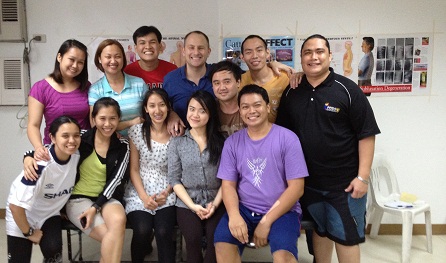
PRESENTOR: LEOMIL P. ADRIANO
PHYSIOTHERAPIST
OSTEOPATH
ACUPUNCTURIST
DIPLOMATE IN OSTEOPATHIC MANIPULATIVE THEORIES AND PRACTICE
MASTER IN PHYSICAL THERAPY (ORTHOPEDICS)
Supported by Dr George Papaphotis DC.DO.ND & Dr Robert Goodrum DO.ND.PT.MSc
Core text
CRANIAL OSTEOPATHY: A PRACTICAL TEXTBOOK by Torsten Liem
Other texts
CRANIOSACRAL THERAPY by John Upledger
CRANIOSACRAL THERAPY II by John Upledger
OSTEOPATHY IN THE CRANIAL FIELD by Harold Magoun (old book)
What is CRANIAL OSTEOPATHY?
Cranial Osteopathy is a field within osteopathic study which treats and manages different maladies, pain, and dysfunction by influencing and manipulating the cranial and sacral system. Cranial Osteopathy is also known as Craniosacral Therapy (CST). The theory starts from the PRIMARY RESPIRATION and deals more with the subtle movement of the craniosacral system.
Course Preparation
To prepare for this intensive course it is best that students review the different landmarks and functions of the cranial vaults as well as the different terminologies from the Goodrum modules and trainings.
Course Objectives
This is a practical course which aims in providing the participants with knowledge and skills for assessing, managing, treating and preventing maladies and dysfunction of the Craniosacral System. The students will be expected to properly evaluate and manage patients who present with craniosacral dysfunctions and their correlates.
Day Plan
The activities of each day will be comprised of lectures, demonstrations and workshops. Return demonstration from the students and participants will be expected. At the end of the ten days, participants should be able to properly deliver a Cranial Osteopathy and/or a Craniosacral Therapy treatment starting from evaluation up to and including management and rehabilitation.
FOUNDATION CRANIAL OSTEOPATHY COURSE (5 DAYS)
The first five days are important in understanding the core concepts of Cranial Osteopathy and Craniosacral Therapy. The topics covered here will prepare the participants for providing basic Cranial Osteopathy treatments.
The core topics are:
• Primary Respiratory Mechanism (PRM)
• Energy Based Science of Osteopathy
• Assessment of PRM
• Cranial Vault Different Lifts
• Still-points
• V spread
• Diaphragm
MODULE 1:
FOUNDATIONAL CRANIOSACRAL THERAPY
1ST DAY and 2ND DAY:
• HISTORY OF CRANIAL SCIENCE
• BASIC ANATOMY AND LANDMARKS
• EMBRYOLOGY
• PRIMARY RESPIRATORY MECHANISM
• ENERGY BASED ON OSTEOPATHY
o FEELING THE CRANIOSACRAL RHYTHM
o SENSING ENERGY EXCESSES AND DEFICIENCIES
• EVALUATION METHODS
• CRANIAL VAULT LIFTS AND RELEASE
•• SACRAL ROCKING AND MOBILIZATION
3RD DAY and 4TH DAY:
• V SPREAD
• STILLPOINTING
• CRANIO MYOFASCIAL CONCEPTS
• DIAPHRAGM DURAL TUBE RELEASES
• CORE LINK TECHNIQUES
• INTRACRANIAL MEMBRANES
• TECHNIQUES FOR BONES AND FLUIDS
• INTEGRATION OF 1ST FOUR DAYS
5TH DAY:
• REVIEW OF THE FIRST 4 DAYS
• PROTOCOLS
• DEMONSTRATION OF A COMPLETE CST MANAGEMENT
• PATIENT EDUCATION
• PRACTICAL EXERCISES
ADVANCE CRANIAL OSTEOPATHY COURSE (5 DAYS)
The next five days are focused on integrating the Cranial Osteopathy and Craniosacral Therapy. The topics covered here will prepare the participants for integrating the CST and Cranial Osteopathy with the other concepts such as meridians and chakras.
The core topics are:
• Review of the core concepts of CST and Cranial Osteopathy
• Sphenoid bones
• Sphenobasilar diagnosis
• Temporomandibular joint
• Meridians
• Chakra
MODULE 2:
DAY6-10 ADVANCE CRANIAL OSTEOPATHY
DAY 6-7:
• REVIEW OF THE BASIC CST COURSE
o PRIMARY RESPIRATION MECHANISM
o LIFTS
o MEMBRANE TECHNIQUES
o DIAPHRAGM
o MYOFASCIAL RELEASE
o CORE LINK TECHNIQUES
• DR. SUTHERLAND’S CONCEPTS OF THE SPHENOID
o STRESS
o STRAIN
o TORSION
o TILTS
• TEMPOROMANDIBULAR JOINT TREATMENT
o IS IT CRANIOMANDIBULAR OR TEMPOROMANDIBULAR JOINT
o DENTAL CONSIDERATIONS
DAY 8-9:
• HARD PALATE AND BONES CONCEPT
• SMALL BONE TECHNIQUE AND MOBILIZATION
• HYDRAULIC CONCEPTS OF CRANIOSACRAL THERAPY
• USING MERIDIAN IN TREATMENT
o EVALUATING THE MERIDIANS
• USING CHAKRA CONCEPT WITH CRANIOSACRAL THERAPY
o HOW THE UNDERSTANDING OF CHAKRAS ENHANCE CRANIOSACRAL THERAPY
DAY 10:
• WHOLE BODY EVALUATION TECHNIQUES
• INTEGRATION OF THE FIRST FOUR DAYS
• UNWINDING AND ADVANCE PROTOCOLS
ARCING TO FIND SOURCE OF PAIN OR DYSFUNCTION
ARCING is a technique in Cranial Osteopathy that searches for the somatic dysfunction by the movement of the therapist’s hands on different areas of the body. Utilization of ARCING allows the therapist to discover sources of dysfunction with greater ease.
CORE LINK TECHNIQUE
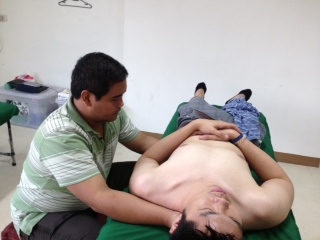
CORE LINK TECHNIQUE can be likened to myofascial release of the whole spine. But unlike myofascial release, this technique uses the craniosacral rhythm in releasing the tension by means of a very light tug at both ends.
CRANIAL BASE RELEASE
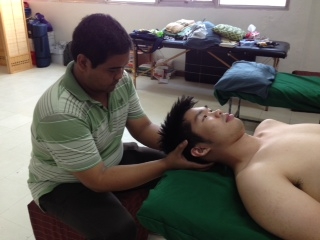
In CRANIAL BASE RELEASE the therapist uses the Cranial Base as the contact area and softly feels for the expansion and contraction of the craniosacral rhythm, and eventually STILLPOINT- a certain period of time when the Craniosacral rhythm stops.
EVALUATION OF INHERENT ENERGY
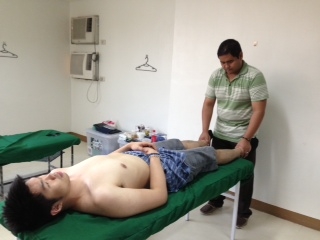
Using the feet, the therapist may evaluate the patient’s inherent energy. By obtaining and comparing the patient’s inherent energy before and after treatment, the therapist can conclude if the patient is improving.
EVALUATING THE CRANIOSACRAL RHYTHM
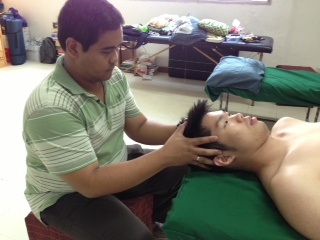
In this procedure the therapist evaluates the speed of the craniosacral rhythm. Usually a normal rhythm will be within 6-12 cycles per minute. Speeds slower or faster than this would indicate possible dysfunction.
FASCIAL UNWINDING OF THE UPPER EXTERMITY
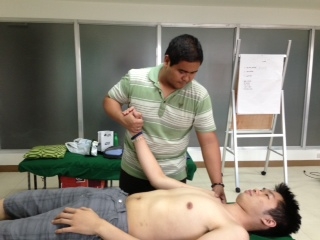
Fascial Unwinding is a maneuver in Cranial Osteopathy designed to unwind or remove tension from the body. Trauma from physical, mental or emotional sources may cause fascial tension or dysfunction. By unwinding the fascia, the body may become more open to healing.
FORMER STYLE OF ARCING
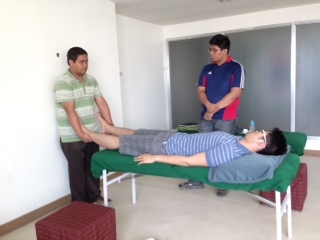
By swinging the legs toward a different direction, the therapist may feel for somatic dysfunction in the patient. This arcing is likened to a table cloth with a plate on top. When moving the table cloth, you may feel the plate on top as it restricts the movement of the whole table cloth!
FRONTAL BONE RELEASE
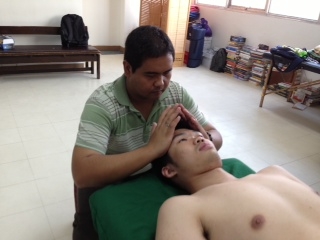
Sometimes, the frontal bone may tighten due to some physical or mental trauma. If the frontal bone is restricted to glide, the patient may experience loss of concentration or focus. Resulting in a need to release and balance the frontal area.
RELEASING THE DIAPHRAGM
Diaphragm in Cranial Osteopathy is not restricted to respiratory diaphragm. These diaphragms are chambers that divide one area from another. If a diaphragm is restricted, the efficient exchange and flow of substance may be compromised, thus creating a need for such release technique.
RELEASING THE LOWER DIAPHRAGM
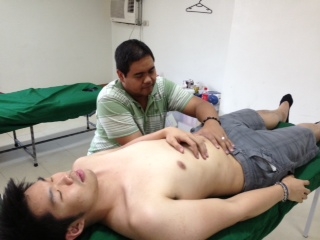
One of the diaphragms that may need to be released is the pelvic diaphragm. This is an area that needs an efficient flow and exchange of substances because it is believed to be necessary for reproduction and even survival.
RELEASING THE UPPER DIAPHRAGM
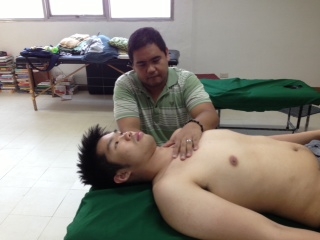
This diaphragm technique is needed especially to ensure an efficient exchange of substances from head to the thorax. Also, this area is most often used in preparation for treatment of the head and/or the upper quadrant.
SPHENOID RELEASE
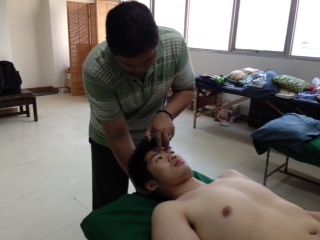
Sphenoid Release is a Cranial Osteopathy technique that is done to influence the sphenobasilar area of the skull. By balancing the sphenoid, certain dysfunctions such as migraines can be treated easily.
V SPREAD
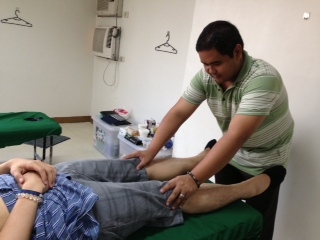
With this technique the therapist uses the forefinger and middle finger in an attempt to shoot energy to a painful spot. This particular technique is effective for acute pain.
Cranial Osteopathy/Cranial Sacral Therapy
In 1899 Dr. Sutherland DO, a former student of Dr Andrew Taylor Still DO, closely observed that the twenty-six bones of the skull were connected by modified pseudo-joints which permitted a tiny degree of motion as viewed through the skull and its membranes, fluids, and the brain within. The small amount of motion can also be felt throughout the body, similar to a breathing mechanism. This small rhythmical change in shape has come to be seen as the body and cranium’s response to the breath of life or primary respiratory mechanism and as an expression of the individual’s state of health and vitality.
When we flex our leg or take a deep breath this is voluntary motion. Cranial Sacral Rhythm is motion beyond our voluntary control and therefore is called involuntary motion or involuntary mechanism.
One of the foundation ideas and principles of Osteopathy is that the living body has haemostasis — a self-balancing, self-regulating, self-primary healing mechanism. The body is continually working to maintain its optimum level of health and vitality.
These osteopathic principles are particularly demonstrated in Cranial Osteopathy, wherein the osteopath tries to be as receptive, or tuned-in, as possible to the intelligence of the inner physician in order to feel and sense how the body is seeking to rebalance and heal.
In this manner the osteopath’s thinking process and perceptive hands join in the effort to ascertain the body’s current state of health. The osteopath can then support or use methods of intervention as required by the patient’s system in order to re-establish balance and healing and to restore the freedom of movement needed to get on with its job of self-healing.
The major concern of the cranial osteopath is that of study and learning to listen through gentle hands-on manual contact of less than 5 grams. The treatment methods begin from this peaceful and quiet respect and receptive attention to the details of the patient’s Cranial Sacral Rhythm or involuntary mechanism.
We offer postgraduate courses in Osteopathy in the Cranial Field, consisting of the two 5-day modules. Attendees may be qualified osteopaths, physiotherapists, chiropractors, or sport therapists with a degree or MD’s.
It takes time to become skilled at using Cranial Osteopathy, as well as development of all areas of Osteopathy. The key concepts need to be understood fully and a considerable amount of theory and practise must be learned. As osteopaths work with this approach in their clinics there will be a gradual refining of skill and understanding. Most osteopaths/practitioners find that a great amount of personal change takes place in their life as they begin to appreciate the potential of Dr. Sutherland’s ideas.
The learning process is not always easy but rather, represents an introduction into the cranial field where the practitioner will be supported each step and never be alone.
There is an important overlap between dentistry and Cranial Osteopathy.
The inter relationship between the teeth and the body is complex.
The osteopath’s opinion of dental issues has impact for the body as a whole.
The teeth are an important part of the structure and the muscles related to jaw clinching and chewing are very strong. The upper teeth rest in the two maxillary bones which form the middle section of the face, the cheek area.
The lower teeth are in the mandible. The lower jaw can move around, because of the action of the temporomandibular joint. Because of the way the teeth bite, the balance between the upper and lower jaw plays a vital role in the balance of the body as a unit.
The TMJ may possibly become noisy, or click, and yield discomfort or even pain. Dental problems can affect the alignment of the TMJ, which may have later effects on the body structure. Imbalances in the body alignment can disturb the TMJ, and then result in upsetting the bite. Additional symptoms may include painful clicks in the jaw, grinding of the teeth in the night, headaches, and neck, shoulder and ear problems. The temporomandibular dysfunction and ear problems are quite common. A Cranial Osteopath can help to diagnose and treat the cause of pain and somatic dysfunction and balance the cranial area/TMJ and whole body.
If a patient is considering major dental work, they may benefit first by visiting a Cranial Osteopath. Likewise, if a child has been offered orthodontic treatment, they may benefit first by having an osteopathic check.
We recommend you study our Spinal Foundation, Advanced & Extremity and Osteopathic Soft Tissue Methods before studying Cranial Osteopathy. Cranial Osteopathy blends very well with Visceral Osteopathy.
Fee $1500USD per 5 day course or $2,800USD for both ten days.
Fee includes accommodation & breakfast in Asia.
